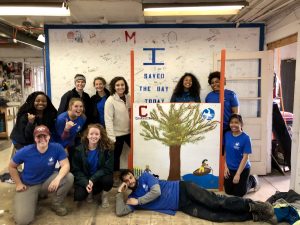On March 17th, ten students, including myself, and a College of Charleston faculty member, headed to Annapolis, Maryland for an Alternative Spring Break. For this Break experience, we were privileged to be introduced to the Chesapeake Bay Foundation. This group works with New York, Pennsylvania, Maryland, Delaware, Virginia, West Virginia and Washington D.C. whose land areas are drained through a network of tributaries into a main waterway whose watershed is the Chesapeake Bay.
During our first day with CBF, we worked on an agricultural farm many miles from the Bay. The farmer has “rented” the outskirts of his land to be planted with a buffer of trees. The trees are involved in the support of a number of services. They provide a carbon sink, prevent soil erosion, help to build healthy soil, create a habitat for other species and are an important filter for runoff from the fertilized crops. The tree buffer is fairly young and our job was to fix supports and shelters around the trees and to plant new trees where others had not previously survived. David Tana, a CBF representative worked with us and explained the importance of trees. To him, the many benefits of trees are huge.
Our second day with CBF was very cold and rainy, which gave us the opportunity to have an education day. The Chesapeake Bay watershed is home to 18 million people and covers 64,000 square miles. The Bay is 35 miles across at the widest and 3.5 miles at the narrowest. Trees, plants and oysters are considered a “green filter” for the area, cleaning runoff and the water in the Bay. Humans have created a “gray funnel” of concrete, with streets, parking lots, and building rooftops where water and everything in it runs right into the watershed. This includes an ever-growing source of pollution by nitrogen, phosphorus and sediments. For this reason, The Chesapeake Bay Foundation is actively working with communities to improve waste water treatment and this involvement has already raised water quality. As we saw with the farm where we worked, they are engaging many farmers to help plant buffers of native trees.
Until the 1980s, oysters had supported the most valuable fishery in the Bay, but as a result of decades of pollution, overharvesting, and disease, the Bay’s native oyster population is now as low as one percent of historic levels. Oysters are a keystone species in the Bay’s ecology as well, because they filter algae, sediment, and other pollutants and in the process, improve water quality and clarity. Their large reefs provide habitat for fish, crabs, and other Bay organisms. Oyster restoration programs are critical to help improve the Bay’s water quality and increase its economic viability, so CBF’s programs give citizens the ways and means needed to help restore native oysters to the Chesapeake. They do not have a very large staff for all of the work that they do, so they believe in working with volunteers and involving community groups. Doing this educates about issues at hand and provides a feeling of closeness with the problem and how to help solve or prevent it. This is key for making a difference and improving the environment and water quality.
On the Fourth day with CBF, we had the opportunity to go out on the water in a boat and conduct a few simple water quality tests, including a turbidity test using a “Secchi Disk.” The depth where the disk is no longer visible is taken as a measure of the transparency of the water, known as “the Secchi depth.” We lowered the disk slowly down into the water and measured 150 cm (59 in) of clarity, which was considered “good.”
On our last day with CBF, we built an “oyster shaker” to clean the oyster shells before they were used for restoration. We also shook a few oysters ourselves, a somewhat dirty, but satisfying job, knowing that the shells were to be returned to the water.
This was a wonderful experience and I hope to have another opportunity to work with the Chesapeake Bay Foundation. I love what they are doing and it has given me confidence and continuing certainty of the value of the direction I am going. We all must work together to create a clean, strong environment for every living being to thrive.


Thank-you for sharing this sweet experience!